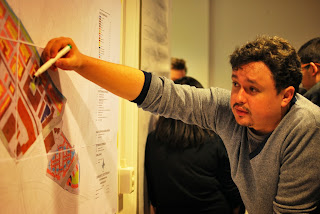Things are already moving so fast. We started this yesterday
and already today we had our first set of presentations. We call it mapping. So,
the last day and a half we were divided into multiple groups and were looking
into different aspects of the site. Walking, looking, interviewing, and taking
pictures…a lot of work, a lot of fun. And today we presented all of our findings.
 |
| Photo Credits: Alexandra Tsatsou |
We were all together nine groups working on three different
divisions, with nine sub-divisions. Let’s run through the findings of us all. First,
we look into the physical mapping of the area. Like mentioned in the last post,
the section of ZoHo is surrounded by roads, and also a water canal. The question
however was, is the area limited by these features or is it actually connected to
the rest of Rotterdam by them? What was found was that, this section, although
it is in the geographical heart of the city, actually has an issue of
connectivity. It is intersected and surrounded by streets and roads but the
cross linking of these spaces is not present. Also, there is a huge difference in
the use of the space, there is un-comparable contrast in the way different nearby
sections of this neighbourhood are used. Certain areas have too much space,
unwanted and unneeded space even, but these areas are not well lit, therefore
the abundant space is unfortunately dead.
But that is not to say there is no potential, the area is
close to the central station of Rotterdam, it is near the tram line so this space
really has good connectivity potential. The physical deadness of the area can
in fact be tackled if functionally it is made more connected and coherent.
Moving on to the second aspect of this space, the
socio-economic parameters are also very varied and in some cases non-complementary.
The social, commercial, institutional and official areas are neither segregated
nor co-working, thus, you find a lot of commercial activities besides a
children’s football ground. Buildings as well as the voids between them are
huge, however some streets are narrow and both cars and bikes use the same
space creating traffic problems. Looking at the residential environment,
majority of the houses are social-housing and have good location and good
prices, so the tenants are satisfied by the neighbourhood but, there can be
seen these problems of coherence. The people who live in this area have other
problems like, the population of young adults of working age is very high (as
compared to the rest of Rotterdam), however their skills are low and the current
demand in the area is for high skill workers. Also, there is high percentage of
people in this area, who are categorized as low-income group. This is also
linked to the education in the area; there is an air of low education and
career aspiration amongst the community. This may also be due to the communal
and cultural differences as well as due to differences seen in gender related
issues. Most educational institutes and community centres are in an area
outside their immediate boundary, and perhaps also outside their comfort zone. The
main barriers for this may be language, culture and ethnicity. There are also
some environmental issues that were found in this area, foremost amongst them are
the facts that although there are many open areas, they are mostly hard-paved,
uninviting spaces. Due to the presence of industrial activity and roads, there
is also a mixed feeling on the noise pollution in this neighbourhood.
A challenge felt here is on the security issue. There are
mixed reactions when it comes to this. The overall reputation of the place gives
an insecure feeling, however on the ground; people do not show the practical
implications of insecurity. However, if you ask different people, they tend to
have a mixed reaction. One can find people walking around the neighbourhood at
the dead on the night without the feeling of insecurity, but, there are also
incidences of anonymous attempts, and success, in breaking windows and the
like.
When you talk to the people, the people living here as well
as the people who are in some ways involved in the area, one can find that
stakeholders like the municipality are very interested to improve the area. There
have been many rules imposed on these sections in the past, but the
municipality is trying to be flexible in order to involve development in these
sections. Many private organizations have worked together with the government
to initiate potentially sustainable programs in the neighbourhood. However, it
is sometimes felt that these initiatives are not exactly what the residents are
interested or invested in. There are artistic communities and environmental
initiatives taking shape in and around the area, but not all of these are
initiated or in some cases even appreciated by the residents. The civil society
is more concerned about employment rather than art. There seems to be a
vertical relation amongst the stakeholders rather than a horizontal one. There are
multiple barriers, but there are multiple initiatives as well as opportunities
also.
Perhaps we can see this situation as a ‘water and oil’ kind
of a situation, where things are there but just not mixing. We have looked into
whatever we can within this one short day, and now our task is to try and mix
things together to make a difference. The next step is to brainstorm, and look
for potential ideas. And we have another short time to do that….looking forward
to the presentation of the ideas on Monday!!!













